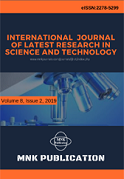DOI:10.29111/ijlrst ISRA Impact Factor:3.35, Peer-reviewed, Open-access Journal
Research Paper Open Access
International Journal of Latest Research in Science and Technology Vol.4 Issue 1, pp 106-110,Year 2015
Correspondence should be addressed to :
Received : 11 February 2015; Accepted : 20 February 2015 ; Published : 28 February 2015

| Download | 126 |
|---|---|
| View | 181 |
| Article No. | 10471 |
In the fluorescence detection system, noise will affect the sensitivity of the system. The method using Stationary Wavelet Transform to de-noise fluorescence signals based on adaptive wavelet entropy is studied. The de-noising effects of dbN families are compared, and then the db7 wavelet is chosen as the optimal wavelet. The noised fluorescence signal is decomposed at 5 levels via Discrete Wavelet Transform or Stationary Wavelet Transform. The thresholded detail coefficients are reconstructed with the approximation coefficients to produce the pure fluorescence signal. It is verified that the de-noising method via Stationary Wavelet Transform has better effect than Discrete Wavelet Transform.
Copyright © 2015 Yutian Wang et al. This is an open access article distributed under the Creative Commons Attribution 4.0 International (CC BY 4.0) license which permits unrestricted use, distribution, and reproduction in any medium, provided the original work is properly cited.
Yutian Wang,Lifang Cao, Pengfei Cheng , " Remove Noise From Fluorescence Signal Of Mineral Oil In Water Using Stationary Wavelet Transform And Wavelet Entropy ", International Journal of Latest Research in Science and Technology . Vol. 4, Issue 1, pp 106-110 , 2015

MNK Publication was founded in 2012 to upholder revolutionary ideas that would advance the research and practice of business and management. Today, we comply with to advance fresh thinking in latest scientific fields where we think we can make a real difference and growth now also including medical and social care, education,management and engineering.

We offers several opportunities for partnership and tie-up with individual, corporate and organizational level. We are working on the open access platform. Editors, authors, readers, librarians and conference organizer can work together. We are giving open opportunities to all. Our team is always willing to work and collaborate to promote open access publication.

Our Journals provide one of the strongest International open access platform for research communities. Our conference proceeding services provide conference organizers a privileged platform for publishing extended conference papers as journal publications. It is deliberated to disseminate scientific research and to establish long term International collaborations and partnerships with academic communities and conference organizers.